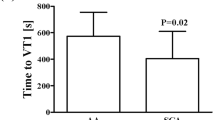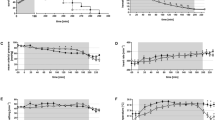Abstract
THE rapid disappearance from circulation of human erythrocytes transfused to rats can be prevented if the animals are pretreated with ethyl palmitate (EP) and a cobra venom factor (CVF)1. The improvement in human erythrocyte survival in these animals is due to EP-induced impairment of reticuloendothelial function2 and to suppression of intravascular haemolysis through CVF inhibition of the third component of complement3. The halflife of normal human erythrocytes in the blood of untreated rats is less than 15 min, but is about 30 h in the EP and CVF treated rats4.
This is a preview of subscription content, access via your institution
Access options
Subscribe to this journal
Receive 51 print issues and online access
$199.00 per year
only $3.90 per issue
Buy this article
- Purchase on Springer Link
- Instant access to full article PDF
Prices may be subject to local taxes which are calculated during checkout
Similar content being viewed by others
References
Wright, M. C., Nelson, R. A., jun., and Finch, S. C., Yale J. Biol. Med., 43, 173–176 (1960).
Stuart, A. E., Lancet, ii, 896–897 (1960).
Nelson, R. A., jun., Surv. Ophthal., 11, 498–505 (1966).
Finch, S. C., Castro, O., Orlin, J., Rosen, M. W., and Aponte, L., Conn. Med., 38, 338–341 (1974).
Bensinger, T. A., and Gillette, P. N., Arch. Int. Med., 133, 624–631 (1974).
Callender, T. E., Nickel, J. F., Moore, C. V., and Powell, E. O., J. lab. clin. Med., 34, 90–104 (1949).
Cerami, A., and Manning, J. M., Proc. natn. Acad. Sci. U.S.A., 68, 1180–1183 (1971).
Castro, O., Orlin, J., Rosen, M. W., and Finch, S. C., Proc. natn. Acad. Sci. U.S.A., 70, 2356–2359 (1973).
Castro, O., Orlin, J., and Finch, S. C., Yale J. Biol. Med., 47, 55–60 (1974).
Castro, O., Orlin, J., Rosen, M. W., and Finch, S. C., Ann. Int. Med. (in the press).
Orlin, J., Castro, O., and Finch, S. C., Clin. Res., 21, 969 (1973).
Author information
Authors and Affiliations
Rights and permissions
About this article
Cite this article
CASTRO, O., FINCH, S. & OSBALDISTON, G. Sickle cell resistance to in vivo hypoxia. Nature 251, 620–621 (1974). https://doi.org/10.1038/251620a0
Received:
Revised:
Issue Date:
DOI: https://doi.org/10.1038/251620a0
Comments
By submitting a comment you agree to abide by our Terms and Community Guidelines. If you find something abusive or that does not comply with our terms or guidelines please flag it as inappropriate.



